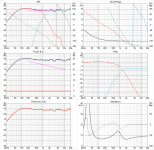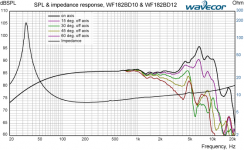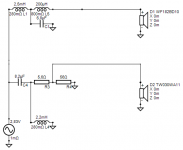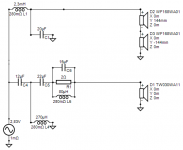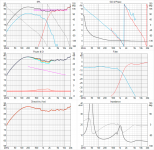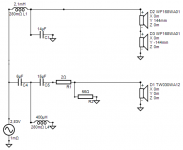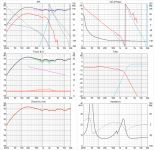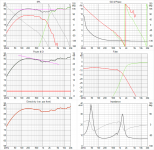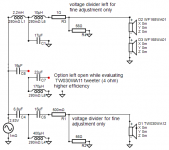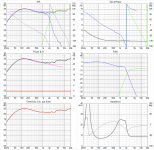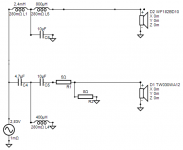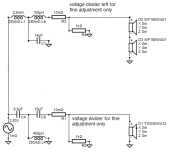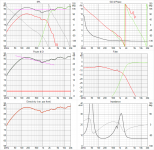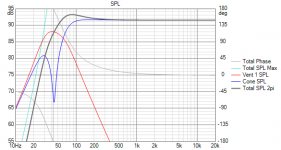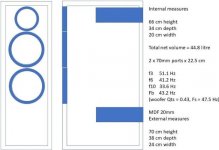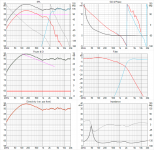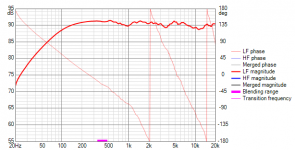Sorry Wolf_teeth, this is my first attempt with crossover and seaker diy "design". Attached the six plots VirtuixCAD shows to me. I'm not trying to hide things, only to learn if I can make it work or not.
Filter is crossing at 1378 Hz now. Don't know if this can wake-up nasty harmonics or strange tweeter response.
Thanks for your patience and advice.
Filter is crossing at 1378 Hz now. Don't know if this can wake-up nasty harmonics or strange tweeter response.
Thanks for your patience and advice.
Attachments
GD and phase- you can tell your driver phases do not meld well at all. They should coincide and track well with each other.
Later,
Wolf
Later,
Wolf
Okey, thanks again. I was not considering that.
So I have to solve a sort of a compromise between three variables now.
1. Attenuate Wavecor's WF182BD10 nasty peak happening at 6942 Hz (driver graph attached).
2. Improve phase coherence in crossover overlapping frequencies.
3. Cross the tweeter above 1500 Hz
After some trial-error I found that smoothing the nasty peak allways worsens phase coherence. I changed woofer crossover from second to third order and noticed the nasty peak is now a little bit smoother (less than 1 dB between 5.9kHz and 6.7kHz, -20dB from target SPL); considering woofer noticeable dispersion at 6.7kHz, I decided to stop here and sacrifice the point 1 further improvement in benefit of points 2 and 3.
Now I have much better phase coherence between 1 kHz and 5kHz, relocated filter crossover point exactly at 2000 Hz, noticing that the SPL response graph crosses at exactly 1500 Hz, so I guess both parameters are now on the safe side.
This is the status of the project now.
Thanks again for the advice.
So I have to solve a sort of a compromise between three variables now.
1. Attenuate Wavecor's WF182BD10 nasty peak happening at 6942 Hz (driver graph attached).
2. Improve phase coherence in crossover overlapping frequencies.
3. Cross the tweeter above 1500 Hz
After some trial-error I found that smoothing the nasty peak allways worsens phase coherence. I changed woofer crossover from second to third order and noticed the nasty peak is now a little bit smoother (less than 1 dB between 5.9kHz and 6.7kHz, -20dB from target SPL); considering woofer noticeable dispersion at 6.7kHz, I decided to stop here and sacrifice the point 1 further improvement in benefit of points 2 and 3.
Now I have much better phase coherence between 1 kHz and 5kHz, relocated filter crossover point exactly at 2000 Hz, noticing that the SPL response graph crosses at exactly 1500 Hz, so I guess both parameters are now on the safe side.
This is the status of the project now.
Thanks again for the advice.
Attachments
the Wavecor WF160WA02 is cheaper (pressed frame), although smaller..., yet easy to crossover, 1st order is OK, perhaps use a pair? I'm using a pair in my main 3.5 way system for the low mids, sounds wonderful....
Will try to run an alternative speaker using the same tweeter but with different woofer. I'm thinking about a WTW using the cheaper driver WF168WA01.
Getting more SPL and not needing to attenuate the tweeter can be interesting.
I believe they have less Xmax so you might not be able to play as loud. But they do look more interesting as a midrange driver.
I missed that you wrote WTW so it might work out in regards of SPL.
I missed that you wrote WTW so it might work out in regards of SPL.
Last edited:
Well, Im enjoying my last sunday summer leave day with good wine, sun, heat, movies and running this crossover simulations. I would thank again Kimmo Saunisto for his great simulation program VituixCAD, it's wonderful.
To the point.
I was investigating deeper on the net, and found that the Wavecor's tweeter TW030WA11 is considered a top performer, but needs to be controlled by using third order crossover. Period. This confirms Wolf_Teeth's advice. Experience wins again.
In view of the above I decided to proceed with third order crossover for the tweeter and to run a simple simulation using a couple of Wavecor's cheap WF168WA01 as woofers in a WTW configuration.
The results are awesome to me. No need to invert polarity. The woofer perfoms quite flat until 2000 Hz. To me there's no need to attenuate anything and no nasty peaks to mitigate in the woofer response.
Having the woofer a sensitivity about 91.5 dB I'm sure it can be a very good performer in a WTW config.
I'm sharing the plots.
The big doubts I have are related to the enclosure, because I'm not familiarized with WTW configuration (or D'Appolito's) so I'm running some math with 35 liter for a ported enclosure, but will be grateful if someome can guide me with a good free enclosure calculator for WTW.
To the point.
I was investigating deeper on the net, and found that the Wavecor's tweeter TW030WA11 is considered a top performer, but needs to be controlled by using third order crossover. Period. This confirms Wolf_Teeth's advice. Experience wins again.
In view of the above I decided to proceed with third order crossover for the tweeter and to run a simple simulation using a couple of Wavecor's cheap WF168WA01 as woofers in a WTW configuration.
The results are awesome to me. No need to invert polarity. The woofer perfoms quite flat until 2000 Hz. To me there's no need to attenuate anything and no nasty peaks to mitigate in the woofer response.
Having the woofer a sensitivity about 91.5 dB I'm sure it can be a very good performer in a WTW config.
I'm sharing the plots.
The big doubts I have are related to the enclosure, because I'm not familiarized with WTW configuration (or D'Appolito's) so I'm running some math with 35 liter for a ported enclosure, but will be grateful if someome can guide me with a good free enclosure calculator for WTW.
Attachments
My objective is an 8 ohm speaker for the future Aleph.
I do not like the impedance graph above, so considered to use the tweeter 8 ohm version instead of the 4 ohm.
This 8 ohm tweeter (the TW030WA12) has 91 dB sensitivity and matches better the woofer pair impedance in WTW config. (8ohm).
I like the overall crossover simulation. Having 90 dB is better for an amplifier with 30 Watts and the impedance seems to be more coherent.
Attached the last graphs.
I do not like the impedance graph above, so considered to use the tweeter 8 ohm version instead of the 4 ohm.
This 8 ohm tweeter (the TW030WA12) has 91 dB sensitivity and matches better the woofer pair impedance in WTW config. (8ohm).
I like the overall crossover simulation. Having 90 dB is better for an amplifier with 30 Watts and the impedance seems to be more coherent.
Attached the last graphs.
Attachments
I believe they have less Xmax so you might not be able to play as loud. But they do look more interesting as a midrange driver.
I missed that you wrote WTW so it might work out in regards of SPL.
Thanks for your comment. The woofer alone has a max. excursion of +/- 3mm but also an effective radiating area of 139 cm2 (x 2 = 278 cm2) and 91,5 dB sensitivity, so I guess they will perform failry well in a WTW configuration almost at the same SPL level of the tweeter.
I'm evaluating two options with very similar cost and maybe performance.
1. one midwoofer + tweeter (WF182BD10 + TW030WA12)
2. two midwoofer + tweeter (2xWF168WA01 + TW030WA12)
As I will need some high efficiency for a 30+30 Watts amp, the latter seems to be a better choice, as can easily grant 91 dB SPL (I have doubts the first could bring 85-86 dB).
Also there is a clear advantage having a big midwoofer radiating area because of the smaller cone excursion and thus less woofer distortion.
On the other hand, the first option can have better bass extension (the woofer is clearly more "bass capable") and the speaker will have lower dimensions.
The only thing already decided is to go with third order crossover in any case, and to leave open the possibility of changing crossover components to fine adjust later (if needed).
In the case of having two midwoofers in a vented enclosure...
Anyone knows if there are advantages putting two vents instead of single vent?

1. one midwoofer + tweeter (WF182BD10 + TW030WA12)
2. two midwoofer + tweeter (2xWF168WA01 + TW030WA12)
As I will need some high efficiency for a 30+30 Watts amp, the latter seems to be a better choice, as can easily grant 91 dB SPL (I have doubts the first could bring 85-86 dB).
Also there is a clear advantage having a big midwoofer radiating area because of the smaller cone excursion and thus less woofer distortion.
On the other hand, the first option can have better bass extension (the woofer is clearly more "bass capable") and the speaker will have lower dimensions.
The only thing already decided is to go with third order crossover in any case, and to leave open the possibility of changing crossover components to fine adjust later (if needed).
In the case of having two midwoofers in a vented enclosure...
Anyone knows if there are advantages putting two vents instead of single vent?

Attached the last simulations with the last adjustments.
Any thoughts?
Any advice about the most recommended enclosure?
Thanks in advance
Any thoughts?
Any advice about the most recommended enclosure?
Thanks in advance
Attachments
Thoughts?
Once you also do consider baffle step and the different z positions of the sound sources, your crossover designs will be very different, but much more realistic! 🙂
Unfortunately, the WF182BD10 with its heavy cone assembly will make only 82 dB in a usual cabinet and result in a low efficiency speaker.
Once you also do consider baffle step and the different z positions of the sound sources, your crossover designs will be very different, but much more realistic! 🙂
Unfortunately, the WF182BD10 with its heavy cone assembly will make only 82 dB in a usual cabinet and result in a low efficiency speaker.
Hi Dissi, thanks for comment.
With "different z positions" Do you mean the vertical axis position of the drivers?.
Regarding baffle step, I don't have any measurement equipment, so I will appreciate your advice on mitigation or adapting measures.
I'm now searching for other people's design to better understand the driver's behavior in the real world, but designers has a different approach that's seems to be some how subjective.
Best
With "different z positions" Do you mean the vertical axis position of the drivers?.
Regarding baffle step, I don't have any measurement equipment, so I will appreciate your advice on mitigation or adapting measures.
I'm now searching for other people's design to better understand the driver's behavior in the real world, but designers has a different approach that's seems to be some how subjective.
Best
I don't use VituixCAD, but as far as I know there's a diffraction tool included which allows to model the baffle step.
The z coordinate of the driver position is perpendicular to the baffle and modifies the individual distance of the sound source to the microphone.
The z coordinate of the driver position is perpendicular to the baffle and modifies the individual distance of the sound source to the microphone.
After some reading to better understand the BSC thing and simulating with VituixCAD "diffraction tool", I found that I'm having a "quasi linear" drop in the baffle SPL, starting from 1 kHz and down to 100 Hz of about 6 dB total.
I was able to make crossover simulations with real drive data measurements for other speakers with the same Wavecor midwoofers and very similar enclosures to explore BSC correction solutions in the "real life", and found that those designers corrected the BSC within the same crossover, I mean, without using additional filtering. In such cases the designers "reversed" the BSC effect just increasing the drop in response from 100-200 Hz to 1 kHz more agressively, but never exceeding the 5 dB.
"Manipulating" lowpass crossover's inductance to compensate BSC seems to work very well in other's designs I simulated, obtaining flat response in their final measurements.
Now, I have a woofer SPL drop (between 200 Hz and 1 kHz) of only 4 dB and will try to increase to 5 dB. This will be my attempt to "correct" baffle step.
Don't know if other speaker designers in the forum have used this same solution or have comments.
I was able to make crossover simulations with real drive data measurements for other speakers with the same Wavecor midwoofers and very similar enclosures to explore BSC correction solutions in the "real life", and found that those designers corrected the BSC within the same crossover, I mean, without using additional filtering. In such cases the designers "reversed" the BSC effect just increasing the drop in response from 100-200 Hz to 1 kHz more agressively, but never exceeding the 5 dB.
"Manipulating" lowpass crossover's inductance to compensate BSC seems to work very well in other's designs I simulated, obtaining flat response in their final measurements.
Now, I have a woofer SPL drop (between 200 Hz and 1 kHz) of only 4 dB and will try to increase to 5 dB. This will be my attempt to "correct" baffle step.
Don't know if other speaker designers in the forum have used this same solution or have comments.
In the meantime I was revising other well known diy speakers as the KAIROS, the CARRERA and the NADA. They all seems to be very top high fidelity speakers, but all of them have also very low sensitivity for my personal purpose of using Nelson Pass Aleph 30 (30+30 watts).
The only very well known diy speaker that I found to fit my personal needs was the PLUTONE, with 90 dB efficiency, but also found that the drivers are very hard to find and the price shall be very high.
So I will try to encourage myself and go ahead with the Wavecor 2x WF168WA01 + TW030WA12 in a WWT configuration. It's the design offering higher sensitivity with lower cost. The drawback is woofer less bass capability, but praised for it's mid range low distortion performance. Will run 35-36 Litre enclosure simulations for these.
The only very well known diy speaker that I found to fit my personal needs was the PLUTONE, with 90 dB efficiency, but also found that the drivers are very hard to find and the price shall be very high.
So I will try to encourage myself and go ahead with the Wavecor 2x WF168WA01 + TW030WA12 in a WWT configuration. It's the design offering higher sensitivity with lower cost. The drawback is woofer less bass capability, but praised for it's mid range low distortion performance. Will run 35-36 Litre enclosure simulations for these.
Attached my first enclosure simulation approach (bassreflex), trying to push bass a little bit while enlarging enclosure (up to the wife hard limits) to keep transient response and overall performance on the safe side (SBB4 calculation). Don't know if can be improved. I still have many doubts, including best port positioning. Will need some help from my friends...
For Wavecor WF168WA01 woofers I'm obtaining an F3 of 51.1 Hz / F6 41.2 Hz. I think it's quite good for a "light" midwoofer with a Qts of 0.43, it's not?
For Wavecor WF168WA01 woofers I'm obtaining an F3 of 51.1 Hz / F6 41.2 Hz. I think it's quite good for a "light" midwoofer with a Qts of 0.43, it's not?
Attachments
Well, after some weekends of simulation, my last budget project blends two 8 ohm midwoofers in paralell (2 x WF168WA02) together with the 4 ohm waveguide tweeter TW030WA11 in a TWW.
Phase is very coherent at the crossover point, SPL looks very flat and impedance is almost constant around 3 ohm (only for discrete amps capable of handling demanding loads).
Attached the 6 pack crossover simulation and the merged response considering the baffle step.
This is not a deep bass speaker confguration, but the ported simulations shows that can give -3dB at 50Hz in a SBB4 alignment which is pretty nice for me, considering the driver data. I guess mids will be outstanding.
Phase is very coherent at the crossover point, SPL looks very flat and impedance is almost constant around 3 ohm (only for discrete amps capable of handling demanding loads).
Attached the 6 pack crossover simulation and the merged response considering the baffle step.
This is not a deep bass speaker confguration, but the ported simulations shows that can give -3dB at 50Hz in a SBB4 alignment which is pretty nice for me, considering the driver data. I guess mids will be outstanding.
Attachments
- Home
- Loudspeakers
- Multi-Way
- Starting my 1st diy speaker project, a simple 2 way with Wavecor drivers
